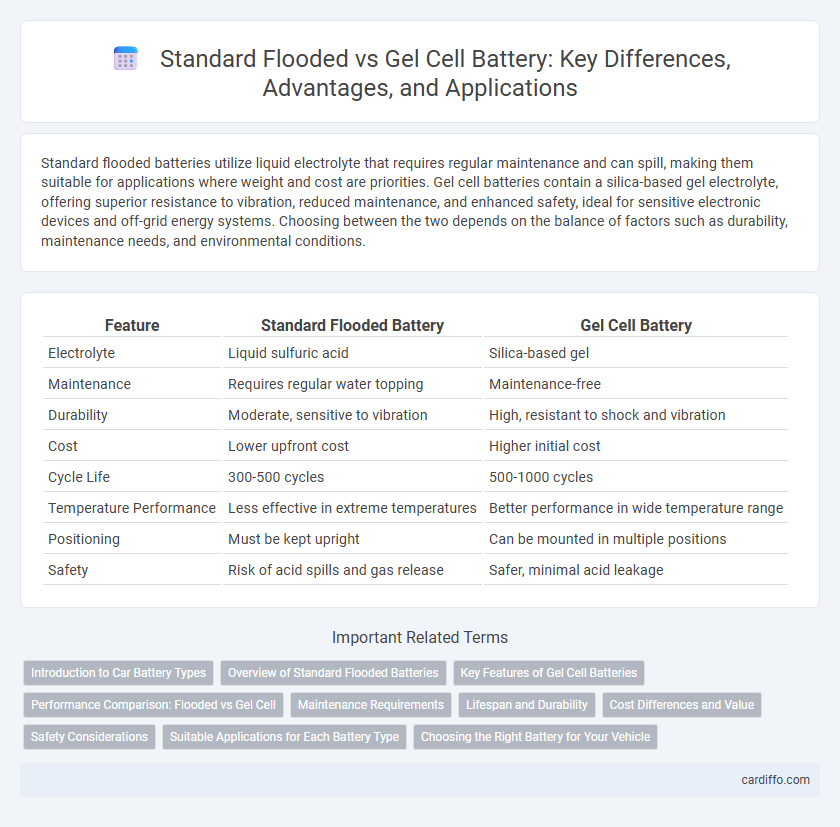Standard flooded batteries utilize liquid electrolyte that requires regular maintenance and can spill, making them suitable for applications where weight and cost are priorities. Gel cell batteries contain a silica-based gel electrolyte, offering superior resistance to vibration, reduced maintenance, and enhanced safety, ideal for sensitive electronic devices and off-grid energy systems. Choosing between the two depends on the balance of factors such as durability, maintenance needs, and environmental conditions.
Table of Comparison
| Feature | Standard Flooded Battery | Gel Cell Battery |
|---|---|---|
| Electrolyte | Liquid sulfuric acid | Silica-based gel |
| Maintenance | Requires regular water topping | Maintenance-free |
| Durability | Moderate, sensitive to vibration | High, resistant to shock and vibration |
| Cost | Lower upfront cost | Higher initial cost |
| Cycle Life | 300-500 cycles | 500-1000 cycles |
| Temperature Performance | Less effective in extreme temperatures | Better performance in wide temperature range |
| Positioning | Must be kept upright | Can be mounted in multiple positions |
| Safety | Risk of acid spills and gas release | Safer, minimal acid leakage |
Introduction to Car Battery Types
Standard Flooded batteries use a liquid electrolyte solution and are known for their affordability and ease of maintenance, making them a common choice for everyday vehicles. Gel Cell batteries contain a silica-based gel electrolyte, offering higher resistance to vibration and temperature extremes, which enhances their durability in off-road and performance applications. Understanding these fundamental differences helps in selecting the right car battery based on driving conditions and maintenance preferences.
Overview of Standard Flooded Batteries
Standard flooded batteries, also known as lead-acid batteries, utilize a liquid electrolyte consisting of sulfuric acid and water, allowing for efficient ion exchange during charge and discharge cycles. These batteries are cost-effective, widely used in automotive and renewable energy applications, and require regular maintenance such as electrolyte level checks and water topping. Their robust design provides reliable performance but they are sensitive to deep discharges and must be properly vented to avoid gas buildup.
Key Features of Gel Cell Batteries
Gel cell batteries use a silica-based electrolyte that solidifies the acid into a gel, preventing spills and making them leak-proof. They offer superior deep-cycle performance, higher resistance to vibration, and operate efficiently across a wide temperature range. These batteries require minimal maintenance, have low self-discharge rates, and provide enhanced safety compared to standard flooded batteries.
Performance Comparison: Flooded vs Gel Cell
Standard flooded batteries deliver consistent high current output and excel in applications requiring rapid discharge and recharge cycles due to their liquid electrolyte design. Gel cell batteries offer superior vibration resistance and longer lifespan by using a silica-based gel electrolyte, which reduces water loss and maintenance needs. Although flooded batteries provide better surge capacity, gel cells outperform in deep cycle durability and challenging environmental conditions.
Maintenance Requirements
Standard flooded batteries require regular maintenance, including checking electrolyte levels and adding distilled water to prevent damage and ensure optimal performance. Gel cell batteries are maintenance-free, as their gelled electrolyte eliminates the need for watering or electrolyte level checks. This difference makes gel cells ideal for applications where low maintenance and durability are critical.
Lifespan and Durability
Standard flooded batteries typically offer a lifespan of 3 to 5 years, with moderate durability due to their liquid electrolyte, which requires regular maintenance to prevent corrosion and electrolyte loss. Gel cell batteries provide enhanced durability with a sealed design that resists vibration and temperature extremes, resulting in a longer lifespan of up to 7 to 10 years with minimal maintenance. The gel electrolyte's stability reduces the risk of acid stratification and leakage, making gel cells more reliable for deep-cycle applications and harsh environments.
Cost Differences and Value
Standard flooded batteries typically offer a lower initial cost compared to gel cell batteries, making them a budget-friendly option for many applications. Gel cell batteries, while more expensive upfront, provide enhanced durability, longer lifespan, and maintenance-free operation, which can result in lower total cost of ownership over time. The value of gel cells is especially evident in deep cycle and harsh environmental conditions, where their superior performance justifies the higher investment.
Safety Considerations
Standard flooded batteries require regular maintenance to prevent acid spills and gas emissions, posing safety risks in enclosed or poorly ventilated spaces. Gel cell batteries use a silica-based gel electrolyte that reduces the risk of leakage and corrosion, making them safer for use in sensitive environments. The sealed design of gel cells also minimizes the release of harmful gases, enhancing overall safety during operation and handling.
Suitable Applications for Each Battery Type
Standard flooded batteries are ideal for automotive starters, backup power supplies, and deep-cycle applications like marine and RV use, where frequent charging and discharging occur. Gel cell batteries excel in sensitive electronics, solar energy storage, and medical equipment due to their vibration resistance, leak-proof design, and maintenance-free operation. The choice depends on environmental conditions, usage patterns, and maintenance capabilities.
Choosing the Right Battery for Your Vehicle
Standard flooded batteries offer cost-effective power with easy maintenance and strong cold-cranking amps, making them suitable for traditional vehicles and harsher environments. Gel cell batteries provide superior vibration resistance and deep cycle capability, ideal for off-road or specialty vehicles requiring longer battery life and reduced electrolyte leakage. Selecting the right battery depends on vehicle type, usage conditions, and desired maintenance level for optimal performance and durability.
Standard Flooded vs Gel Cell Infographic

 cardiffo.com
cardiffo.com